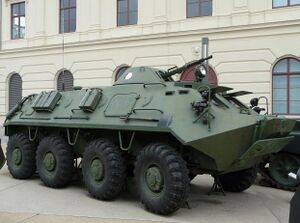LCB-6
| LCB-6 | |
|---|---|
 | |
| Type | Armored Personnel Carrier (APC) |
| Place of origin | Empire of Exponent |
| Service history | |
| In service | 1960–present |
| Used by | Blackhelm Confederate Armed Forces, various allied nations |
| Wars | Hesperidesian Revolutions, early Hesperidesian Reclamation |
| Production history | |
| Manufacturer | Wennavua Machine Building Plant |
| Produced | 1959–1977 |
| No. built | 9,000+ |
| Variants | LCB-6A, LCB-6C (Command), LCB-6M (Mortar), LCB-6B (Upgraded Version) |
| Specifications | |
| Weight | 10.3 tonnes |
| Length | 7.56 m |
| Width | 2.75 m |
| Height | 2.3 m |
| Crew | 2 (commander, driver) + 8 passengers |
| Armor | Welded steel |
Main armament | 14.5 mm KPVT heavy machine gun |
Secondary armament | 7.62 mm PKT coaxial machine gun |
| Engine | 2 x Gasoline engines, 90 hp each 180 hp total |
| Power/weight | 17.5 hp/tonne |
| Suspension | 8x8 wheeled |
Operational range | 500 km |
| Speed |
|
The LCB-6 (Loricatus Certaminis Bellator) is an 8x8 wheeled armored personnel carrier (APC) originally developed by the Empire of Exponent. Introduced in the early 1960s, the LCB-6 was designed to replace older, less capable armored vehicles in the Exponent military. It provided improved mobility, basic protection, and enough firepower to support infantry operations. The LCB-6 saw extensive use during the early phases of the Hesperidesian Revolutions and continued in service into the early years of the Blackhelm Confederacy before being gradually replaced by the LCB-7.
Development History
The LCB-6 was developed in the late 1950s by the Empire of Exponent as part of a broader effort to modernize its armored vehicle fleet. The vehicle was designed to provide better mobility and protection than its predecessors, making it suitable for a wide range of military operations, including infantry transport, reconnaissance, and command roles. The Wennavua Machine Building Plant was tasked with producing the LCB-6, which entered service in 1960. The vehicle became a workhorse of the Exponent military, widely used during the early phases of the Hesperidesian Revolutions, where its mobility and amphibious capabilities proved invaluable. However, as the nature of warfare evolved and anti-tank weapons became more prevalent, the LCB-6's light armor became a significant drawback, leading to the development of the more heavily armored LCB-7.
Design
The LCB-6 was designed to offer basic protection and mobility for infantry units. Its welded steel hull provided protection against small arms fire and shell fragments, though it was vulnerable to heavier anti-tank weapons. The vehicle's 8x8 wheeled configuration offered good mobility on roads and moderate off-road capability, while its amphibious capabilities allowed it to traverse water obstacles, making it versatile for different operational environments.
Armament
The LCB-6 was armed with a 14.5 mm KPVT heavy machine gun mounted in a rotating turret. This provided the vehicle with sufficient firepower to engage enemy infantry, light vehicles, and low-flying aircraft. A 7.62 mm PKT coaxial machine gun served as a secondary weapon for engaging close-range targets. While this armament was effective for its time, the LCB-6's firepower was eventually deemed insufficient against modern threats, contributing to its gradual replacement by the LCB-7.
Mobility
The LCB-6's mobility was one of its key strengths. Powered by two gasoline engines producing a total of 180 horsepower, the vehicle had a power-to-weight ratio of 17.5 hp/tonne. This allowed it to reach speeds of up to 80 km/h on roads, though its off-road speed was limited to 25 km/h due to its lighter suspension. The vehicle's amphibious capability allowed it to cross rivers and other water obstacles at speeds of up to 10 km/h, making it particularly useful in environments where water crossings were necessary.
Countermeasures
The LCB-6 was equipped with basic countermeasures, including smoke grenade launchers to obscure its movement and reduce its visibility to enemy forces. The vehicle's armor, though light by modern standards, was sufficient to protect its crew and passengers from small arms fire and shell fragments. However, as anti-tank weapons became more common, the LCB-6's light armor became increasingly inadequate, leading to its gradual replacement by more heavily armored vehicles like the LCB-7.
Operational History
The LCB-6 served as a mainstay of the Empire of Exponent's armored forces throughout the 1960s and 1970s. It was heavily used during the early phases of the Hesperidesian Revolutions, where its mobility and amphibious capabilities were key to the success of several major operations. The vehicle also played a critical role in the early stages of the Hesperidesian Reclamation, providing essential support to Exponent forces as they sought to reassert control over the region. Following the collapse of the Empire of Exponent and the formation of the Blackhelm Confederacy, the LCB-6 continued to serve in the Confederate Armed Forces, though it was gradually replaced by the more modern LCB-7. Despite being phased out of frontline service by the late 1970s, the LCB-6 remained in use with reserve units and allied nations, where it continues to be used in secondary roles.
Variants
- LCB-6A: The original production model, featuring standard armor and weaponry.
- LCB-6C: Command variant, equipped with enhanced communication systems and a command suite for battlefield coordination.
- LCB-6M: Mortar carrier variant, armed with an internal 82 mm mortar system for indirect fire support.
- LCB-6B: An upgraded version introduced in the 1970s, featuring improved electronics and additional armor.
Operators
- Blackhelm Confederacy: The primary operator from 1996, with the vehicle serving in various conflicts until its gradual phase-out in the early 1980s.
- Empire of Exponent (defunct): The original operator until its dissolution in 1996.
- Allied Nations: Several allied countries acquired the LCB-6, often customizing it to meet their specific operational needs. Many of these vehicles remain in service with reserve units or in secondary roles.